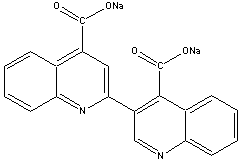
|
BCA Protein Assay Kit(Protein Assay) BCA Kit BCA Protein Assay Kit[ 979-88-4 ] f.w: 344.33 daltons |
Protein determination is one of the most common operations performed in biochemical research. The principle of the bicinchoninic acid ( BCA ) assay is similar to the Lowry procedure, in that both rely on the formation of a Cu+2 protein complex under alkaline conditions, followed by reduction of the Cu+2 to Cu+1. The amount of reduction is proportional to the protein present. It has been shown that cysteine, trytophan, tyrosine and the peptide bond are able to reduce Cu+2 to Cu+1. BCA - bicinchoninic acid forms a purple blue complex with Cu+1 in alkaline solutions. This provides a basis to monitor the reduction of alkaline Cu+2 by proteins and thus determine the protein concentration in a biochemical sample. Bicinchoninic acid is a highly chromogenic reagent when complexed with Cu+1, forming a purple blue complex with an absorbance maximum at 562 nanometers. The absorbance is directly proportional to the protein concentration.

| Quantity | Price | |
|---|---|---|
| 250 determinations + | $42.00 |  |
| 500 determinations + | $75.00 |  |
| 1000 determinations + | $95.00 |  |
| 3750 determinations + | $340.00 |  |
Protein determination is one of the most common operations performed in biochemical research. The principle of the bicinchoninic acid ( BCA ) assay is similar to the Lowry procedure, in that both rely on the formation of a Cu+2 protein complex under alkaline conditions, followed by reduction of the Cu+2 to Cu+1. The amount of reduction is proportional to the protein present. It has been shown that cysteine, trytophan, tyrosine and the peptide bond are able to reduce Cu+2 to Cu+1. BCA - bicinchoninic acid forms a purple blue complex with Cu+1 in alkaline solutions. This provides a basis to monitor the reduction of alkaline Cu+2 by proteins and thus determine the protein concentration in a biochemical sample. Bicinchoninic acid is a highly chromogenic reagent when complexed with Cu+1, forming a purple blue complex with an absorbance maximum at 562 nanometers. The absorbance is directly proportional to the protein concentration.
1. Smith, P.K., et al, Anal. Biochem., Measurement of Protein Using Bicinchoninic Acid, 150, 76-85 (1985)